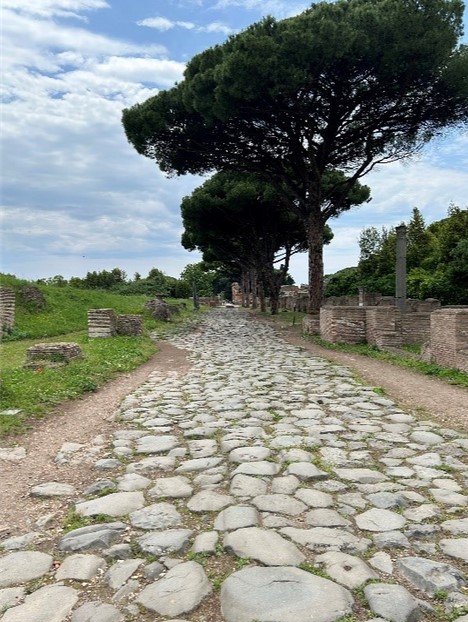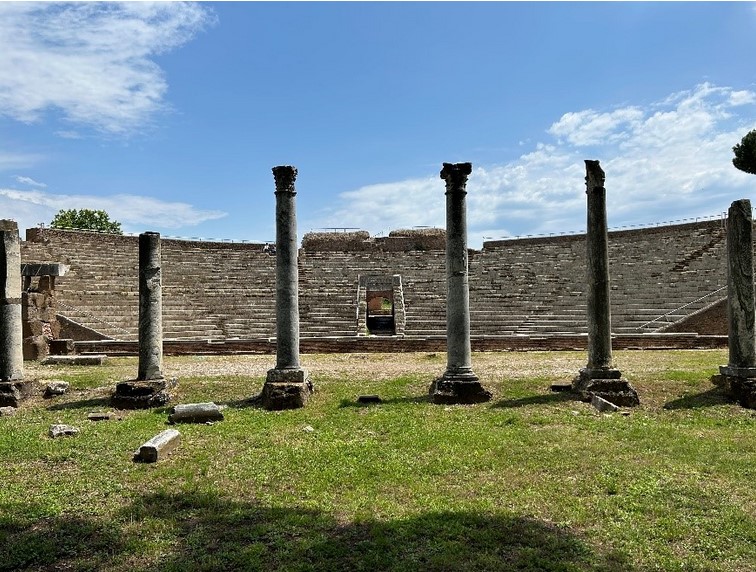Tags
BGSU History, BGSU Study Abroad, Casey Stark, Jo Enger Arthur Scholarship for Study Abroad, Nathaniel Brooks, Ostia Antica, Roma Aeterna, Rome, Undergraduate
By Nathaniel Brooks, BGSU Roma Aeterna 2023 Student
The figure above shows the central road through which traffic and shipments would flow in and out of Ostia Antica. The city, its name Latin for “ancient entrance”, once sat at the mouth of the Tiber River and on the coast of the Mediterranean Sea. This prime location made it of strategic importance to whatever power held it. Situated barely 25 kilometers west of Rome, it would be under their influence that the city prospered and grew. According to the ancient historian Livy, the city was founded by the fourth king of Rome, Ancus Marcius, during the middling days of the monarchy. Throughout much of this period, Ostia Antica would act as the westernmost border of Rome’s territory (Livy 1.33). If Livy’s claims are to be taken as fact, that would make Ostia Antica one of, if not the first of Rome’s colonies. Given Rome’s position on the Tiber but dozens of kilometers away from the sea, founding a port city was an important step in expanding their interests in the Italian Peninsula. Today, Ostia Antica sits abandoned, a rare glimpse of the remains of an ancient city like that of Pompeii. But it was decline, rather than natural disaster, that spelled the end of it. Ostia Antica began as a singular and vital port for Rome, but as the empire expanded and the center of power shifted away from Italy, it began a period of decline that would culminate in the city’s eventual abandonment.
In the early days of the Republic, Rome saw a massive territorial expansion across Italy, fighting and conquering Latin-speaking peoples and aggressively expanding land until the peninsula was entirely Roman-dominated. But Ostia Antica would not see its relevance until the First Punic War. Now facing Carthage, a North African rival and a powerful maritime city, for the first time in its history Rome saw a need to expand its seafaring capabilities beyond coastal defense. Ostia Antica served as its first naval base, from which it would send several fleets out to do battle with Carthage over the course of the Punic Wars. During this period, it would serve as the permanent seat of one of Rome’s quaestors, a master of a fleet. Inhabitants of the city were even reportedly not allowed to serve in Rome’s army, as they were instead expected to be working either at the docks or in the navy. The city’s tradition of early Roman pioneers of the Mediterranean is represented by the prominence of Neptune, the Roman god of the sea. Figure 2 shows an elaborate mosaic depicting the god near the aptly titled Baths of Neptune within the city.
Around the second century B.C.E., Ostia Antica saw a significant shift from a military base into a commercial port for the city of Rome. With Rome’s maritime enemies marginalized and an ever-growing population in its city, feeding the inhabitants of Rome became a higher priority than servicing its navy. Once again, Ostia Antica’s location became its greatest advantage, as it acted as a gateway to Rome through which grain from across the Republic could be shipped. The traditional fleet commander of the city, the quaestor, came to serve less of a military role and more of an economic one. The quaestor was increasingly charged with overseeing the shipments of grain arriving in the city and ensuring their timely delivery to Rome. This transition from a naval base to a commercial port had unforeseen consequences, however. Not only did this increase the city’s vulnerability, but it increased its value to any seeking to target the city which is exactly occurred during Sulla’s Civil War. The historian Appian claims that the city was captured and sacked by Gaius Marius and his supporters in the year 87 B.C.E. (Appian 1.8). Marius likely recognized not only the city’s value for loot and valuables, but also its strategic importance. By capturing the city, he was cutting off its vital supply of food, effectively starving Rome’s population and strangling the city’s trading capabilities in a single stroke. Unfortunately, this would not be the last time the city was targeted for these reasons, and the vulnerability that Rome faced because of Ostia Antica would be demonstrated.
Ostia Antica’s newfound role as a commercial port to Rome was a lucrative position, but it would not be long lasting. Rome’s expansion not only meant increased business for the port city, but it also meant increased competition as well. Still, its position as Rome’s closest port city meant that for the time being, it remained an important center for trade. Its significance is demonstrated by the swift action taken by the Senate following another attack on the city. In his writings, the orator Marcus Tullius Cicero described the city being sacked in 68 B.C.E., the result of a fleet of pirates converging on the city. The pirates destroyed a Roman fleet stationed there and kidnapped several senators (Cicero, On Pompey’s Command, 12). Gnaeus Pompey would proceed to encourage the Senate to raise another fleet and hunt down the pirates in response, and following their defeat a new set of walls were erected around the city to further increase its defense. It was during this period that the famous Porta Romano was constructed, the grand gateway leading into the city. These defensive walls, built mostly under the guidance of Marcus Tullius Cicero, would prove successful in defending the city for several centuries. But while the Senate had acted fast in securing the safety of Ostia Antica, the sacking by pirates seemed to raise alarms regarding the security of their grain access. It is during the late Republican period that Rome would begin to expand its port cities, becoming more reliant on Alexandria and Carthage instead.
Ostia Antica saw the height of its prominence and population in the early days of the Empire. The city would become a common site for Roman emperors to visit and bestow their favor to, a form of maintaining ties to what was still a significant trading hub in Italy at the time. Figure 3 shows Ostia Antica’s main theater, a large outdoor amphitheater constructed by Marcus Agrippa, the right-hand man and general to Emperor Caesar Augustus. Agrippa was not the only powerful figure to leave his mark on the city. From Emperor Claudius’s expanded harbor to Emperor Trajan’s canal system and new basin, Ostia Antica saw its infrastructure peak alongside the Empire itself.
In her article on the city, author Diana Millar claims that the Third Century C.E. saw the many problems facing Ostia Antica reach their breaking point. The shift of trade from Ostia and towards the newer port, Portus, made Ostia increasingly irrelevant, while the rapid succession of emperors from 235-285 C.E. drew attention away from domestic problems. Finally, the splitting of the empire under Emperor Diocletian led to the western emperor moving to Ravenna, a port city that no longer had use for Ostia Antica (Millar). Millar indicates that the Crisis of the Third Century only exacerbated issues that the city was already facing for centuries prior. The decision to split the empire administratively had been caused by its massive expansion, as had the increased reliance on other port cities like Portus and Ravenna. While the Third Century saw tremendous decline for Ostia Antica, the Fourth and Fifth Centuries saw the collapse and eventual abandonment of the city entirely. As the population of Rome fell, so too did Ostia’s, as work dried up and public buildings fell into disrepair. During the collapse of the Western Roman Empire the city was largely abandoned as an administrative center, and by the Ninth Century C.E. it had been entirely abandoned by its remaining inhabitants. Increase silting had destroyed what little value the port city had once had, effectively blocking its access to the Mediterranean Sea.
Ostia Antica is a city that was both symbolically and intrinsically tied to the neighboring city Rome. Archaeologists studying the paleontology of the city’s lagoons found that the city of Ostia Antica’s location at the mouth of the Tiber River “played a key role in the development of the cultures of central Italy and especially of Rome” (Vittori et al.). But as Rome expanded its territory and its center of power began to shift away from Italy, the usefulness of its first colony began to decrease. During the Late Republican era, other port cities like Alexandria and Carthage became useful in transporting grain shipments as well, while Ostia was increasingly attacked during civil wars and pirate raids. While the early to middle Empire was a stabilizing presence, as the power shifted increasingly from Rome other cities became more vital as port cities than Ostia Antica was. Its downfall was marked by the reign of Diocletian, whose decision to divide the empire for stability ended up shifting the capital to Ravenna, making the gateway to the Tiber River and the western Mediterrenean redundant for feeding the capital. Effectively, it was Rome’s expansion and shift away from its historic ties to the Tiber and the ancient city that spelled the end of Ostia Antica as an important city. What had once been the lifeline of grain and trade became increasingly irrelevant as the scale of the empire grew and better options became available. Today Ostia Antica sits as an abandoned Roman city, a glimpse into the past. But it also sits as a reminder of how far Rome came from its humble origins on the Tiber River. As Rome’s first colony, the ancient entrance to the Mediterranean mirrors the decline of the civilization itself.
Works Cited
Appian, The Civil Wars, Book 1 Chapter 8 (ed. Horace White Ph.D., 1899).
Brooks, Nathaniel. Ostia Antica. 21 May, 2023. Photographs.
Cicero, On Pompey’s Command, Chapter 12 (ed. J.B. Greenough Ph.D., G.L. Kittredge Ph.D., 1919).
Millar, Diana. “Ostia Antica: A Roman City.” Agora (Melbourne, Vic.) 52, no. 2 (2017): 36-42.
Titus Livius (Livy), The History of Rome, Book 1 Chapter 33 (ed. Benjamin Oliver Foster, Ph.D., 1919).
Vittori, Cecile, Ilaria Mazzini, Ferreol Salomon, Jean-Phillippe Goiran, Simona Pannuzi, Carlo Rosa, and Angelo Pellegrino. “Palaeoenvironmental Evolution of the Ancient Lagoon of Ostia Antica (Tiber Delta, Italy).” Journal of Archaeological Science 54, (2015): 374-384.



